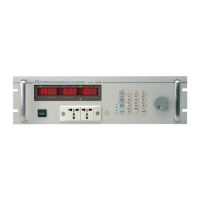Programmable AC Source 6430/6420/6415 User‘s Manual
6.3.5 Basic Definition
Command Tree Table:
The commands of AC source are based on a hierarchical structure, also known as a tree system.
To obtain a particular command, the full path to it must be specified. This path is represented in
the table by placing the highest node in the hierarchy in the far left position. The lower nodes in
the hierarchy are indented in position to the right, below the parent node.
Program Headers:
The program headers are keywords that identify the command. They follow the syntax
described in subsection 7.6 of IEEE 488.2. The AC source accepts both upper-case and
lower-case characters without distinguishing the cases. The program headers consist of two
distinct types, common command headers and instrument-controlled headers.
Common Command and Query Headers:
The syntax of common command and query program header is specified in IEEE 488.2. It is
used together with the IEEE 488.2-defined common commands and queries. The commands with
the leading "*" are common commands.
Instrument-Controlled Headers:
Instrument-controlled headers are used for all other instrument commands. Each
instrument-controlled header has both a long and a short forms. The AC source accepts only the
exact short and the exact long forms. Note that elsewhere in this chapter a special notation is
employed to differentiate the short form header from the long form header of the same header.
The long form of the header is shown in upper-case characters with the portion of short form
whereas the rest of the header in lower-case characters.
Program Header Separator:
Data must be separated from program header by at least one space.
Program Message:
It represents a sequence of zero or more program message unit elements separated by program
message unit separator elements.
Program Message Unit:
It represents a single command, programming data, or query.
6-4

